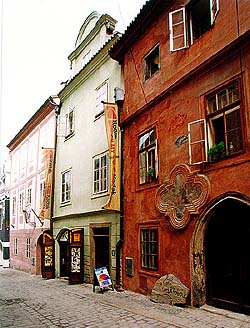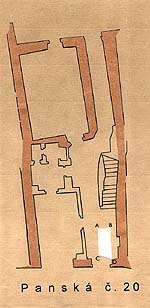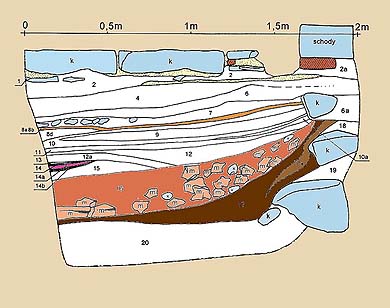The archaeological research of the house No.20 in Panská Street
 The house
No. 20 in Panská Street is first mentioned in 1459. The Gothic
ground-floor peripheral walls and the back chamber walls opened up
with the archaic ridge portal dating from the 14th century. The
elongated housing plot originally continued through the yard (today
empty) and took in a part of the house
No. 30 in Dlouhá Street.
The house
No. 20 in Panská Street is first mentioned in 1459. The Gothic
ground-floor peripheral walls and the back chamber walls opened up
with the archaic ridge portal dating from the 14th century. The
elongated housing plot originally continued through the yard (today
empty) and took in a part of the house
No. 30 in Dlouhá Street.
In 1994 the limited archaeological probing was done by the workers (The Český Krumlov District National History and Geography Museum). They managed to search the half-ground cellar - destroyed during the fire in the last third of the 13th century. There was the gravel-sand underlay (layer 20 ) then the cultural black-and-brown earth layer (layer 17) with a large number of pottery fragments dating from the 13th century and about 40 cm thick loose brown-and-red layer with many large pieces of pottery clay (mostly 20 cm in diameter). Those may have been the pottery clay remains from the wooden walls which probably fell into the half-ground cellar during the fire. Other 26 very thin level scouring and burning layers were uncovered. They contained of a large number of pottery fragments dating from the 13th century and the early of the 14th century. The front wall (in Panská Street) of the today house links to the only searched south wall of the half-ground cellar dating from the 13th century.
At the end of the 13th century the building with its front wall led to Panská Street as well as the today house No. 20. There used to be the half-ground cellar with the built out wall and ceiling construction and pottery clay in the front part of the house. We do not have any evidence of the surface part of the building.

|

|
The building was destroyed during the fire before the end of the 13th century. Its signs were discovered by the archaeological research. The original building was replaced with the stone house.
(me)
Further information :
The archaeological researches in the town of Český
Krumlov
The archaeological research of the medieval town of Český
Krumlov

